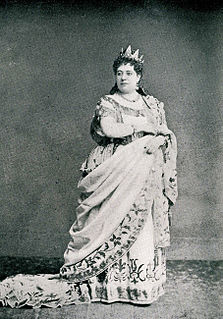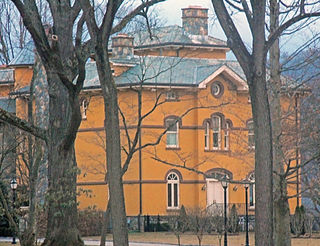
Lucrezia Borgia was a Spanish-Italian noblewoman of the House of Borgia who was the daughter of Pope Alexander VI and Vannozza dei Cattanei. She reigned as the Governor of Spoleto, a position usually held by cardinals, in her own right.

Lucrezia Borgia is a melodramatic opera in a prologue and two acts by Gaetano Donizetti. Felice Romani wrote the Italian libretto after the play Lucrezia Borgia by Victor Hugo, in its turn after the legend of Lucrezia Borgia. Lucrezia Borgia was first performed on 26 December 1833 at La Scala, Milan.

The Nightingale–Brown House is a historic house at 357 Benefit Street on College Hill in Providence, Rhode Island. It is home to the John Nicholas Brown Center for Public Humanities and Cultural Heritage at Brown University. The house is architecturally significant as one of the largest surviving wood-frame houses of the 18th century, and is historically significant as the longtime seat of the Brown family, whose members have been leaders of the Providence civic, social, and business community since the 17th century, and include nationally significant leaders of America's industrialization in the 19th century. The house was listed on the National Register of Historic Places and declared a National Historic Landmark in 1989.

Heritage Square is a place in Fayetteville, North Carolina. Owned and maintained by The Woman's Club of Fayetteville, Heritage Square includes the Sandford House, built in 1797; the Oval Ballroom, a freestanding single room built in 1818; and the Baker-Haigh-Nimocks House, constructed in 1804. The buildings located on Heritage Square are listed in the National Register of Historic Places as the "Fayetteville Woman's Club and Oval Ballroom" and "Nimocks House."

Catherine Flannagan and Margaret Higgins were Irish sisters who were convicted of poisoning and murdering one person in Liverpool, England, and suspected of four more deaths. The women collected a burial society payout on each death, and were found to have been committing murders using arsenic to obtain the insurance money. Although Flannagan evaded police for a time, both sisters were caught and convicted of one of the murders; they were both hanged on the same day at Kirkdale Prison. Modern investigation of the crime has raised the possibility that the sisters were part of a larger conspiracy of murder-for-profit—a network of "black widows"—but no convictions were ever obtained for any of the alleged conspiracy members other than the two sisters.

Boxhill, also called Winkworth, is a Georgian Revival house in Glenview, Kentucky, a small city east of Louisville, Kentucky. It was built in 1906 or 1910 and added to the National Register of Historic Places in 1983.

The Italian Center is the name commonly used for a mid-19th-century house that is home to the organization of the same name on Mill Street in Poughkeepsie, New York, United States. It is a contributing property to the Mill Street-North Clover Street Historic District.

The Oliver Barrett House is located on Reagan Road in the Town of North East, New York, United States, south of the village of Millerton. It is a frame farmhouse built in the mid-19th century, possibly on the site or with materials from another, older house. In the early 20th century it underwent substantial renovations, particularly of its interior. Later in the century it was subdivided into rental units, a conversion reversed by more recent owners.

The Michael Salyer Stone House is located on Blue Hill Road in Orangetown, New York, United States. It was built in the late 18th century.

The Captain Enoch Lord House, also known as Red House, is a historic house at 17 Tantummaheag Road in Old Lyme, Connecticut. Built about 1748, the house is significant both for its long historic association with the colonial Lord family, who were influential participants in the founding of both the Connecticut Colony and the Saybrook Colony, and for its transformation in the late 19th century into a summer estate. The house was listed on the National Register of Historic Places in 2007.

Preston Manor is the former manor house of the ancient Sussex village of Preston, now part of the coastal city of Brighton and Hove, England. The present building dates mostly from 1738, when Lord of the manor Thomas Western rebuilt the original 13th-century structure, and 1905 when Charles Stanley Peach's renovation and enlargement gave the house its current appearance. The manor house passed through several owners, including the Stanfords—reputedly the richest family in Sussex—after several centuries of ownership by the Diocese of Chichester and a period in which it was Crown property.

Cherry Hill is a historic house located on South Pearl Street in Albany, New York, United States. It is a timber frame structure dating to the late 18th century. In 1971 it was listed on the National Register of Historic Places, one of the first properties in the city to receive that designation.

Rock Lawn is a historic house in Garrison, New York, United States. It was built in the mid-19th century from a design by architect Richard Upjohn. In 1982 it was listed on the National Register of Historic Places along with its carriage house, designed by Stanford White and built around 1880.

The Williams–DuBois House is located at Grace Lane and Pinesbridge Road in New Castle, New York, United States. It was built by an early settler of the area during the Revolutionary War. In 1989 it was listed on the National Register of Historic Places.

The Edward Harden Mansion, also known as Broad Oaks, is a historic home located on North Broadway in Sleepy Hollow, New York, United States, on the boundary between it and neighboring Tarrytown. It is a brick building in the Georgian Revival style designed by Hunt & Hunt in the early 20th century, one of the few mansions left of many that lined Broadway in the era it was built. Also on the property is a wood frame carriage house that predates it slightly. Both buildings were listed on the National Register of Historic Places in 2003.

The Delavan Terrace Historic District is located along the street of that name in Northwest Yonkers, New York, United States. It consists of 10 buildings, all houses. In 1983 it was recognized as a historic district and listed on the National Register of Historic Places.

Gibraltar, located at 2505 Pennsylvania Avenue in Wilmington, Delaware, is a country estate home dating from c. 1844 that is listed on the National Register of Historic Places. It takes its name from the Rock of Gibraltar, alluding to the high rocky outcrop on which the house was built. It is located just inside Wilmington's city limits and originally stood at the center of a much larger estate which has over time been reduced to the present area of about a city block in size. The house was originally built by John Rodney Brincklé and inherited by his brother's wife and children, before being bought in 1909 by Hugh Rodney Sharp, who was linked to the Du Pont family through marriage and work. Sharp expanded and remodeled the house, as well as commissioning the pioneering female landscape designer Marian Cruger Coffin to lay out the gardens.

Valley View is a mid-19th-century Greek Revival residence and farm overlooking the South Branch Potomac River northwest of Romney, West Virginia. The house is atop a promontory where Depot Valley joins the South Branch Potomac River valley.

Louisa Collins 11 August 1847 – 8 January 1889) was an Australian poisoner and convicted murderer. Collins, who was dubbed the "Borgia of Botany" by the press of the day, endured four trials in front of 48 men, after the first three juries failed to convict. Collins was hanged at Darlinghurst Gaol on the morning of 8 January 1889.
Sarah Jane Robinson, known as The Boston Borgia, was an Irish-born American serial killer who poisoned her family members and other people from 1881 to 1886, with the help of her accomplices Thomas R. Smith and Dr. Charles C. Beers. She was initially sentenced to death for the poisoning of her brother-in-law, but the verdict was later changed to life imprisonment, with Robinson dying behind bars.























